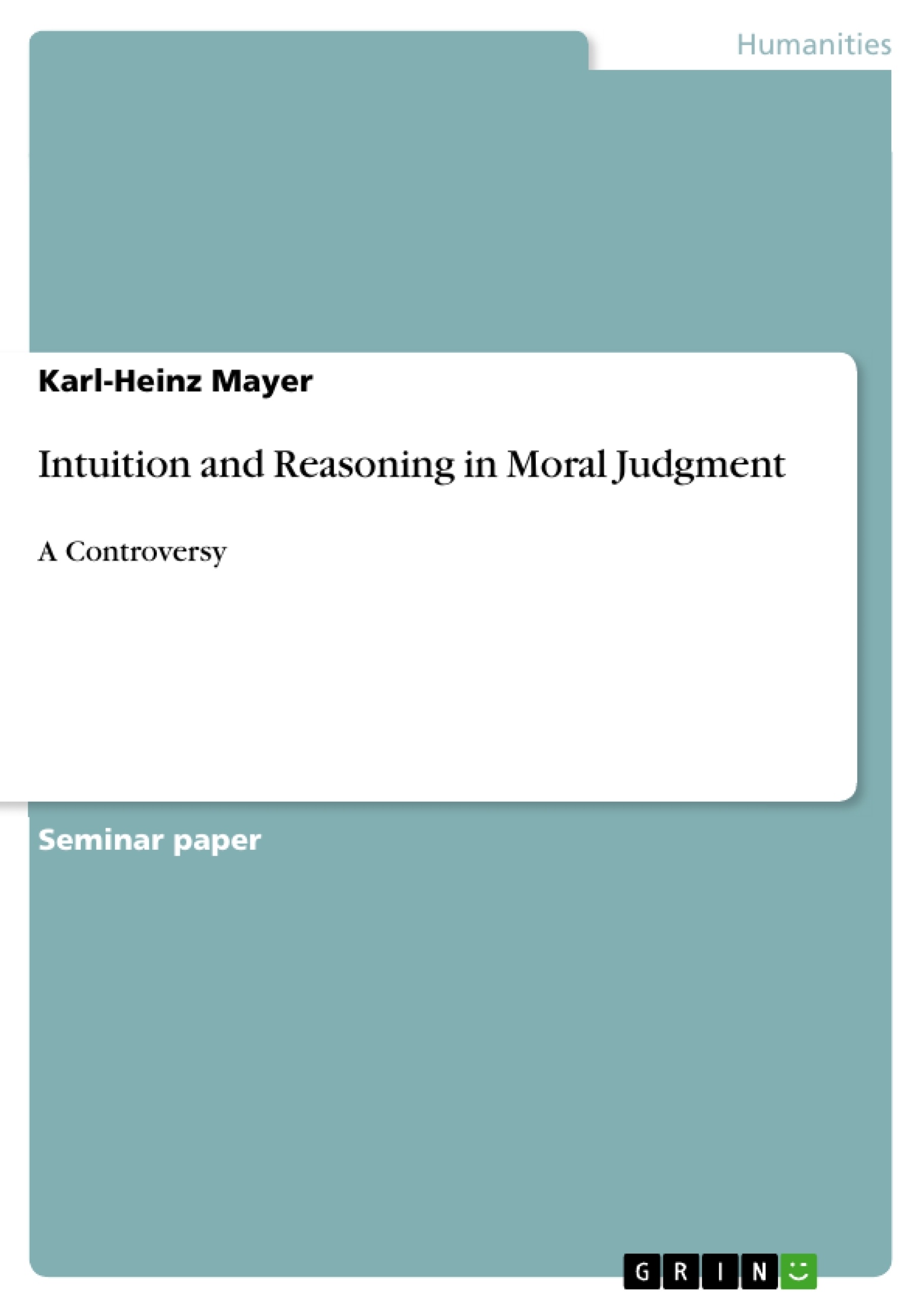Excerpt
Contents
1. Introduction
2. The Neurophysiology of Moral Judgment
3. The Social Intuitionist Approach to Moral Judgment
4. A pertinent controversy
Objections to Haidt (2001) by Pizarro and Bloom
Cognitive Appraisal
Control over the input
Reply by Jonathan Haidt to the objections by Pizarro and Bloom
5. Evaluation of the arguments
6. Philosophical Aspects of the dilemma discussed.
7. Conclusion
8. References:
1. Introduction
This seminar paper is about the balance between intuition and affect on one hand, and conscious reasoning on the other, in moral decisions. The basis for this analysis consists of recent neurobiological and psychological research.
The paper first looks for some input from Neurophysiology to understand what is known about the “wiring” in our brain for moral decisions. Are moral judgments effectuated in the “rational” cortical regions of the brain or in the “intuitive”, affective, and emotional subcortical region?
It then presents a controversy between Jonathan Haidt and Pizarro and Bloom over the predominance of intuition over reasoning in moral judgment. Jonathan Haidt proposes a theory called Social Intuitionist Approach that postulates a priority of intuition over reason, combined with a social component. Moral decisions are predominantly intuitive, he argues, and reason is primarily used to justify the decision afterwards.
Pizarro and Bloom are not fully convinced. While they agree with some parts of Haidt’s theory, they contradict his overall conclusion about the dominance of intuition over reason. In their opinion there is sufficient room for training one’s intuitions and for rationally preparing moral decisions.
Haidt counters the counter-arguments, but concedes that statistical data are missing, which would allow a final assessment of the matter.
I’ll try then to offer my personal assessment of the matter and, finally, I’ll summarize some philosophical considerations regarding this debate.
2. The Neurophysiology of Moral Judgment
Recent research in Psychology and Neurophysiology suggests that the traditional picture of moral decision making as a result of conscious reasoning and comparing of alternative ways of action is coming under scrutiny. Cushman et al. (2010, 47) mention two major challenges to the classical cognitive development paradigm in regard to moral judgment:
- Moral judgment “takes the form of intuition, accomplished by rapid, automatic, and unconscious psychological processes” (ibid.)
- It “is driven primarily by affective responses”. (ibid.)
These challenges are based on evidence from psychological experiments and they lead to new theories about moral decision making. Strong arguments are pointing towards the theory that “moral judgment is accomplished by multiple systems” (Cushman 2010: 48). In the case of Cushman et al., a dual-process approach is pursued, consisting of “both intuitive and rational psychological processes” (ibid.).
Evidence from psychological experiments, such as the well-known “switch dilemma”, shows that consequentialist or utilitarian reasoning is often overridden by intuitive emotional and affective responses, particularly when decisions have to be made under stress, such as limited time, or close contact to persons affected by a moral decision.
To better understand this phenomenon, and to find supporting evidence for the resulting dual-process theory, it seems worth the while to examine the inner workings of our brain in regard to moral motivation and decision making, as described and documented in a graphic chart, Exhibit 1, taken from Schroeder et al. (2010: 80):
As shown, cortical and subcortical regions are involved in the process of moral motivation, judgment, and decision making. Though the graphic chart focuses on moral motivation, it clearly shows two different brain areas involved in moral decisions: cortical and sub-cortical. Within the cortical regions, perception and belief structures are furnishing signals about the environment to different areas for further processing:
- The orbitofrontal cortex is responsible for reward information, which is passed on to the affective striatum to stimulate or reduce dopamine production, depending on the input.
- The motor prefrontal cortex has a regulative function in regard to immediate prior intentions.
- The motor basal ganglia are providing a selection system for action. Schroeder et al. compare it with a schoolyard full of children with diverging intentions (cf. 2010: 81). Using input from the perception- and reward-centers as well from the amygdala, they provide the functionality of selecting among the conflicting possible actions, allowing just one at a time to be realized.
This organization of the brain supports and makes understandable, in my opinion, the dual process theory of moral judgment. It demonstrates that rational as well as affective and emotional input is provided to the Motor Basal Ganglia, where the final selection and decision occurs.
However, this does not answer the question as to which of those influences is stronger. Jonathan Haidt is convinced to have found the answer in his social intuitionist approach to moral judgment.
3. The Social Intuitionist Approach to Moral Judgment
Jonathan Haidt presents this approach as an alternative to rationalist models of moral judgment. Ethical intuitionism is presented as a position that holds that “there are moral truths and that when people grasp these truths they do so not by a process of ratiocination and reflection but rather by a process more akin to perception” (Haidt 2001: 814). This is still a kind of cognition, but it is not reasoning.
This intuitionist model is combined by Haidt with a social component that makes moral judgment into an interpersonal process (ibid.). Moral judgment is intuitive but after having decided, “when faced with a social demand for verbal justification, one becomes a lawyer trying to build a case rather than a judge searching for the truth” (ibid.). Reason only appears at a point in time when the decision has already been made and it is used only for ex post justification.
[...]
- Quote paper
- Karl-Heinz Mayer (Author), 2013, Intuition and Reasoning in Moral Judgment, Munich, GRIN Verlag, https://www.grin.com/document/304273
Publish now - it's free






















Comments